#womens tops online Australia
Explore tagged Tumblr posts
Text
Womens tops online Australia
Discover a wide range of women's tops online in Australia, offering trendy designs and comfortable fits. From casual tees to chic blouses, find versatile styles for any occasion. Shop now for affordable fashion delivered across Australia!
#ladies tops online australia#women tops online#ladies tops online#womens tops online australia#buy tops online australia
0 notes
Text
Shop Our Luxurious High Quality Silk Fabric Online In Australia
Are you looking for the best quality high-quality silk fabric? Look no further than Jemala. Our premium-grade silk fabric is made with unmatched attention to detail, offering you a luxurious look and feel every time. With a wide range of colours and textures, we ensure you get the perfect silk fabric for your wardrobe. Simply put, our silk fabric is the best quality you can find. We take pride in our products and want to ensure that they meet your expectations every time. From shopping to shipping, we provide everything that runs so you can easily shop. If a problem arises, do not hesitate to contact us for mopre details about high quality silk fabric online; we will do our best to resolve it quickly and effectively.
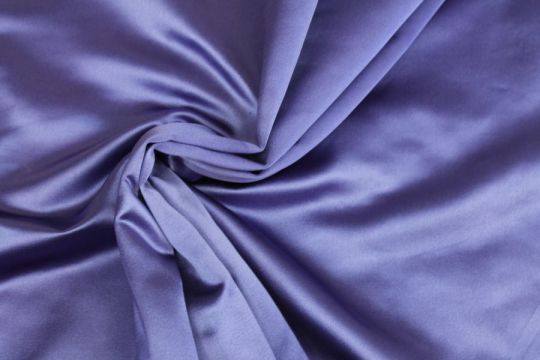
#sustainable wool yarn australia#sustainable wool sweaters#high end women's scarves australia#designer scarves for women australia#women's luxury designer clothing#crew neck sweater womens#australian made knitwear#indigenous scarves australia#kiton men's clothing#womens sweaters australia#luxury knitwear australia#sustainable tops australia#mens designer clothes online
3 notes
·
View notes
Text
We are well known for turning fashion into a sustainable statement! Discover the charm and savings of women's second hand clothing in Australia. Our curated collection offers high-quality, stylish pieces at a fraction of the original price, making eco-friendly fashion accessible and exciting. Whether you're hunting for a unique vintage find or a trendy outfit with a story, our selection provides endless possibilities to refresh your wardrobe. Embrace the thrill of fashion discovery and support sustainable style. Ready to elevate your look while making a positive impact? Dive into our collection today and find your new favourites!
#women's second hand clothing in Australia#women's second hand clothing#buy second hand women's clothes#second-hand women's clothing#buy women's second hand clothing online#shop womens second hand clothing#preloved clothing online Australia#buy preloved womens clothing online#best online second hand clothes Australia#affordable women's clothing online Australia#buy second hand womens clothes#women's top#women's skirts#women's pants#women's maternity clothing
1 note
·
View note
Text
Buy Tops and Tees For Women Online in Australia
Ontree Gold is your go-to destination to buy tops and tees for women online in Australia. Our collection showcases a variety of styles, from trendy tees to elegant tops, perfect for every occasion. Crafted with quality and comfort in mind, our range caters to all fashion preferences. Embrace the convenience of online shopping with Ontree Gold and update your wardrobe with our stylish, versatile selections. Experience fashion at its finest today.
0 notes
Text
The Ultimate Guide to Matching Perfumes with Occasions and Outfits

Choosing the right perfume can be a daunting task, but with the help of the ultimate guide to matching perfumes with occasions and outfits, it doesn't have to be. Scent God is an online perfume store that offers a wide range of high-quality fragrances that are perfect for any event or outfit. Whether you're looking for a floral scent for a spring wedding, a spicy fragrance for a night out, or a fresh perfume for a day at the office, Scent God has got you covered. With their extensive collection of perfumes, you can easily find the perfect scent to match any occasion or outfit. Plus, their helpful guide will provide you with tips and tricks to help you choose the perfect fragrance for any situation. So, whether you're dressing up for a special occasion or simply looking for a new signature scent, Scent God is the place to go for all your perfume needs.
#top fragrances for women#dior homme intense australia#online perfume store#buy perfume online#buy women perfume#buy fragrance online#buy luxurious fragrance
0 notes
Text
VIRAL BATIK SPAN (CREEPER CREATIVE)
Batik Viral SPAN. WARNA MENYERLAH DAN LAIN DARI YANG LAIN. Cepat LOCK DESIGN ANDA sekarnag !! 017 220 8845 ( ADMIN )

View On WordPress
#Baju Custom Made#Baju F1 Korporat Lelaki#Baju F1 Korporat Murah#Baju F1 Sukan#Baju Korporat Muslimah#Cheap Womens Business Shirts Online#Women&039;s Work Tops And Blouses#Womens Business Shirts Australia#Womens Office Shirts#Womens Work Shirts Australia
0 notes
Text
Explore Leading Online Store For Men's Vintage Clothing Australia
If you love vintage style and want to try something new, look no further than Curvique Vintage! We have a great range of Men's Vintage Clothing Australia and have accessories to choose from, so you can find something to suit your style. We have a vast range of vintage clothing in Australia that will make you stand out. Our clothes are made with the highest quality materials and attention to detail, so you can be sure they will last for years. With our vast range of products, we can meet all your needs. Have a look today!

#women clothing vintage#rockabilly clothing australia online#retro clothing online australia#flower hair accessories australia#vintage style clothing australia#plus size tops australia#vintage clothing australia online store#vintage dresses australia#vintage style dresses australia
1 note
·
View note
Text
Where It’s Most Dangerous to Be Black in America

Black Americans made up 13.6% of the US population in 2022 and 54.1% of the victims of murder and non-negligent manslaughter, aka homicide. That works out, according to Centers for Disease Control and Prevention data, to a homicide rate of 29.8 per 100,000 Black Americans and four per 100,000 of everybody else.(1)
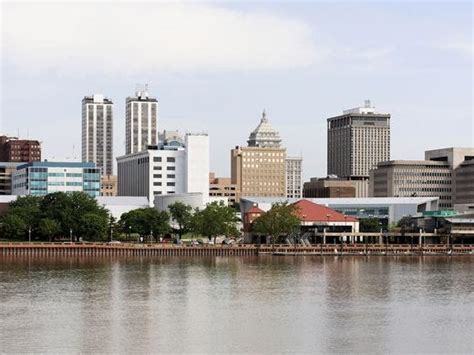
A homicide rate of four per 100,000 is still quite high by wealthy-nation standards. The most up-to-date statistics available from the Organization for Economic Cooperation and Development show a homicide of rate one per 100,000 in Canada as of 2019, 0.8 in Australia (2021), 0.4 in France (2017) and Germany (2020), 0.3 in the UK (2020) and 0.2 in Japan (2020).
But 29.8 per 100,000 is appalling, similar to or higher than the homicide rates of notoriously dangerous Brazil, Colombia and Mexico. It also represents a sharp increase from the early and mid-2010s, when the Black homicide rate in the US hit new (post-1968) lows and so did the gap between it and the rate for everybody else. When the homicide rate goes up, Black Americans suffer disproportionately. When it falls, as it did last year and appears to be doing again this year, it is mostly Black lives that are saved.
As hinted in the chart, racial definitions have changed a bit lately; the US Census Bureau and other government statistics agencies have become more open to classifying Americans as multiracial. The statistics cited in the first paragraph of this column are for those counted as Black or African American only. An additional 1.4% of the US population was Black and one or more other race in 2022, according to the Census Bureau, but the CDC Wonder (for “Wide-ranging Online Data for Epidemiologic Research”) databases from which most of the statistics in this column are drawn don’t provide population estimates or calculate mortality rates for this group. My estimate is that its homicide rate in 2022 was about six per 100,000.
A more detailed breakdown by race, ethnicity and gender reveals that Asian Americans had by far the lowest homicide rate in 2022, 1.6, which didn’t rise during the pandemic, that Hispanic Americans had similar homicide rates to the nation as a whole and that men were more than four times likelier than women to die by homicide in 2022. The biggest standout remained the homicide rate for Black Americans.

Black people are also more likely to be victims of other violent crime, although the differential is smaller than with homicides. In the 2021 National Crime Victimization Survey from the Bureau of Justice Statistics (the 2022 edition will be out soon), the rate of violent crime victimization was 18.5 per 1,000 Black Americans, 16.1 for Whites, 15.9 for Hispanics and 9.9 for Asians, Native Hawaiians and other Pacific Islanders. Understandably, Black Americans are more concerned about crime than others, with 81% telling Pew Research Center pollsters before the 2022 midterm elections that violent crime was a “very important” issue, compared with 65% of Hispanics and 56% of Whites.
These disparities mainly involve communities caught in cycles of violence, not external predators. Of the killers of Black Americans in 2020 whose race was known, 89.4% were Black, according to the FBI. That doesn’t make those deaths any less of a tragedy or public health emergency. Homicide is seventh on the CDC’s list of the 15 leading causes of death among Black Americans, while for other Americans it’s nowhere near the top 15. For Black men ages 15 to 39, the highest-risk group, it’s usually No. 1, although in 2022 the rise in accidental drug overdoses appears to have pushed accidents just past it. For other young men, it’s a distant third behind accidents and suicides.
To be clear, I do not have a solution for this awful problem, or even much of an explanation. But the CDC statistics make clear that sky-high Black homicide rates are not inevitable. They were much lower just a few years ago, for one thing, and they’re far lower in some parts of the US than in others. Here are the overall 2022 homicide rates for the country’s 30 most populous metropolitan areas.
Metropolitan areas are agglomerations of counties by which economic and demographic data are frequently reported, but seldom crime statistics because the patchwork of different law enforcement agencies in each metro area makes it so hard. Even the CDC, which gets its mortality data from state health departments, doesn’t make it easy, which is why I stopped at 30 metro areas.(2)
Sorting the data this way does obscure one key fact about homicide rates: They tend to be much higher in the main city of a metro area than in the surrounding suburbs.
But looking at homicides by metro area allows for more informative comparisons across regions than city crime statistics do, given that cities vary in how much territory they cover and how well they reflect an area’s demographic makeup. Because the CDC suppresses mortality data for privacy reasons whenever there are fewer than 10 deaths to report, large metro areas are good vehicles for looking at racial disparities. Here are the 30 largest metro areas, ranked by the gap between the homicide rates for Black residents and for everybody else.
The biggest gap by far is in metropolitan St. Louis, which also has the highest overall homicide rate. The smallest gaps are in metropolitan San Diego, New York and Boston, which have the lowest homicide rates. Homicide rates are higher for everybody in metro St. Louis than in metro New York, but for Black residents they’re six times higher while for everyone else they’re just less than twice as high.
There do seem to be some regional patterns to this mayhem. The metro areas with the biggest racial gaps are (with the glaring exception of Portland, Oregon) mostly in the Rust Belt, those with the smallest are mostly (with the glaring exceptions of Boston and New York) in the Sun Belt. Look at a map of Black homicide rates by state, and the highest are clustered along the Mississippi River and its major tributaries. Southern states outside of that zone and Western states occupy roughly the same middle ground, while the Northeast and a few middle-of-the-country states with small Black populations are the safest for their Black inhabitants.(3)
Metropolitan areas in the Rust Belt and parts of the South stand out for the isolation of their Black residents, according to a 2021 study of Census data from Brown University’s Diversity and Disparities Project, with the average Black person living in a neighborhood that is 60% or more Black in the Detroit; Jackson, Mississippi; Memphis; Chicago; Cleveland and Milwaukee metro areas in 2020 (in metro St. Louis the percentage was 57.6%). Then again, metro New York and Boston score near the top on another of the project’s measures of residential segregation, which tracks the percentage of a minority group’s members who live in neighborhoods where they are over-concentrated compared with White residents, so segregation clearly doesn’t explain everything.
Looking at changes over time in homicide rates may explain more. Here’s the long view for Black residents of the three biggest metro areas. Again, racial definitions have changed recently. This time I’ve used the new, narrower definition of Black or African American for 2018 onward, and given estimates in a footnote of how much it biases the rates upward compared with the old definition.
All three metro areas had very high Black homicide rates in the 1970s and 1980s, and all three experienced big declines in the 1990s and 2000s. But metro Chicago’s stayed relatively high in the early 2010s then began a rebound in mid-decade that as of 2021 had brought the homicide rate for its Black residents to a record high, even factoring in the boost to the rate from the definitional change.
What happened in Chicago? One answer may lie in the growing body of research documenting what some have called the “Ferguson effect,” in which incidents of police violence that go viral and beget widespread protests are followed by local increases in violent crime, most likely because police pull back on enforcement. Ferguson is the St. Louis suburb where a 2014 killing by police that local prosecutors and the US Justice Department later deemed to have been in self-defense led to widespread protests that were followed by big increases in St. Louis-area homicide rates. Baltimore had a similar viral death in police custody and homicide-rate increase in 2015. In Chicago, it was the October 2014 shooting death of a teenager, and more specifically the release a year later of a video that contradicted police accounts of the incident, leading eventually to the conviction of a police officer for second-degree murder.

It’s not that police killings themselves are a leading cause of death among Black Americans. The Mapping Police Violence database lists 285 killings of Black victims by police in 2022, and the CDC reports 209 Black victims of “legal intervention,” compared with 13,435 Black homicide victims. And while Black Americans are killed by police at a higher rate relative to population than White Americans, this disparity — 2.9 to 1 since 2013, according to Mapping Police Violence — is much less than the 7.5-to-1 ratio for homicides overall in 2022. It’s the loss of trust between law enforcement agencies and the communities they serve that seems to be disproportionately deadly for Black residents of those communities.
The May 2020 murder of George Floyd by a Minneapolis police officer was the most viral such incident yet, leading to protests nationwide and even abroad, as well as an abortive local attempt to disband and replace the police department. The Minneapolis area subsequently experienced large increases in homicides and especially homicides of Black residents. But nine other large metro areas experienced even bigger increases in the Black homicide rate from 2019 to 2022.
A lot of other things happened between 2019 and 2022 besides the Floyd protests, of course, and I certainly wouldn’t ascribe all or most of the pandemic homicide-rate increase to the Ferguson effect. It is interesting, though, that the St. Louis area experienced one of the smallest percentage increases in the Black homicide rate during this period, and it decreased in metro Baltimore.
Also interesting is that the metro areas experiencing the biggest percentage increases in Black residents’ homicide rates were all in the West (if your definition of West is expansive enough to include San Antonio). If this were confined to affluent areas such as Portland, Seattle, San Diego and San Francisco, I could probably spin a plausible-sounding story about it being linked to especially stringent pandemic policies and high work-from-home rates, but that doesn’t fit Phoenix, San Antonio or Las Vegas, so I think I should just admit that I’m stumped.
The standout in a bad way has been the Portland area, which had some of the longest-running and most contentious protests over policing, along with many other sources of dysfunction. The area’s homicide rate for Black residents has more than tripled since 2019 and is now second highest among the 30 biggest metro areas after St. Louis. Again, I don’t have any real solutions to offer here, but whatever the Portland area has been doing since 2019 isn’t working.
(1) The CDC data for 2022 are provisional, with a few revisions still being made in the causes assigned to deaths (was it a homicide or an accident, for example), but I’ve been watching for weeks now, and the changes have been minimal. The CDC is still using 2021 population numbers to calculate 2022 mortality rates, and when it updates those, the homicide rates will change again, but again only slightly. The metropolitan-area numbers also don’t reflect a recent update by the White House Office of Management and Budget to its list of metro areas and the counties that belong to them, which when incorporated will bring yet more small mortality-rate changes. To get these statistics from the CDC mortality databases, I clicked on “Injury Intent and Mechanism” and then on “Homicide”; in some past columns I instead chose “ICD-10 Codes” and then “Assault,” which delivered slightly different numbers.
(2) It’s easy to download mortality statistics by metro area for the years 1999 to 2016, but the databases covering earlier and later years do not offer this option, and one instead has to select all the counties in a metro area to get area-wide statistics, which takes a while.
(3) The map covers the years 2018-2022 to maximize the number of states for which CDC Wonder will cough up data, although as you can see it wouldn’t divulge any numbers for Idaho, Maine, Vermont and Wyoming (meaning there were fewer than 10 homicides of Black residents in each state over that period) and given the small numbers involved, I wouldn’t put a whole lot of stock in the rates for the Dakotas, Hawaii, Maine and Montana.
(https://www.washingtonpost.com/business/2023/09/14/where-it-s-most-dangerous-to-be-black-in-america/cdea7922-52f0-11ee-accf-88c266213aac_story.html)
139 notes
·
View notes
Text
Rip Curl could just have had three brand ambassadors, one for the men's line, one for the women's line and a trans person for a body inclusive line. But no they did the lazy thing and fired the woman and have a man wearing women's clothes.
By Shay Woulahan January 28, 2024
An Australian brand that specializes in swimwear for surfers has come under fire after bringing on a trans-identified male as one of their “female” brand ambassadors. Rip Curl’s controversial move comes just months after the company dropped Bethany Hamilton, a shark attack victim, for voicing her opposition to trans-identified males competing in female sporting competitions.
Rip Curl cut ties with Hamilton in November 2023, despite her status as one of the most celebrated female surfers in Australia and abroad. The decision came after Hamilton publicly opposed gender ideology policies which permit males to compete against women.
Last February, Hamilton shared two videos to her Instagram account questioning October 2022 guidelines adopted by the World Surf League, in accordance with the International Surfing Association, which granted males who claim a transgender status permission to compete against female athletes.

“Is a hormone level an honest and accurate depiction that someone indeed is a male or female? Is it as simple as this?” she asked. In her follow up video, she questioned the policy again. “Am I just a hormone number? Is it as simple as that?”
In her reaction to the new guidelines, Hamilton had also threatened to boycott the World Surf League, and has been outspoken in support of fairness in women’s sports on social media since.
On January 24, Rip Curl posted a video on their women-focused Instagram page, Rip Curl Women, which featured Sasha Jane Lowerson, a trans-identified male surfer.
In the description of the video, Rip Curl described Lowerson, 44, as “a West Australian waterwoman who loves the freedom found in surfing, disconnecting from the mainstream, and the feeling of dancing on constantly changing waves.”
Seemingly anticipating a flood of negative responses, Rip Curl locked their Instagram comments in an effort to limit discussion on their new ambassador.
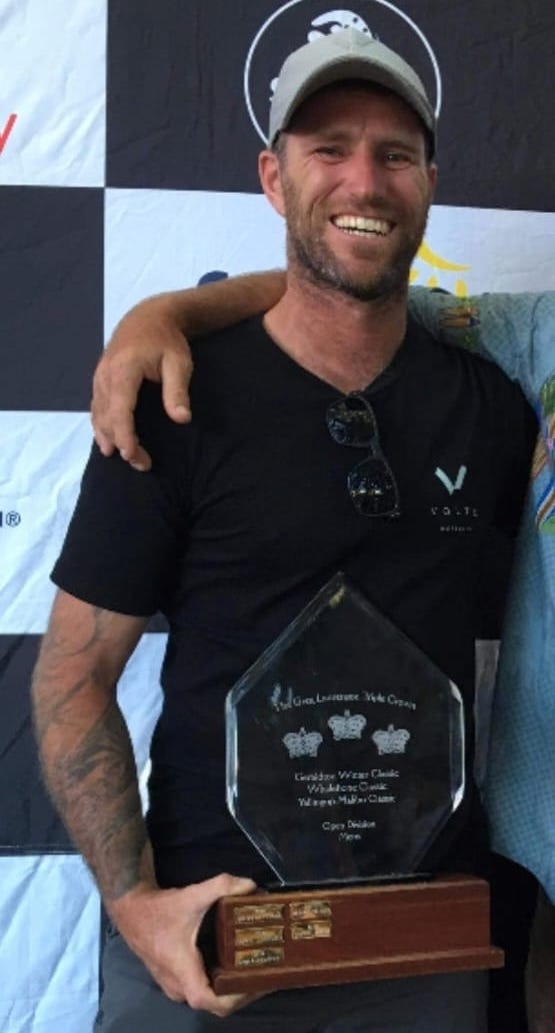
Lowerson competed successfully in men’s surfing competitions prior to identifying as a “woman.”
“With a commitment to maintaining a positive space for all, we have disabled our comments. Thank you for your understanding,” the sportswear company added.
Lowerson drew criticism in 2022 after taking first in both the Open Women’s Longboard and Open Women’s Logger events at the West Coast Suspensions state championships. Just three years prior to competing in the women’s category, Lowerson, competing under the name Ryan Egan, had taken a top position in the men’s category.
Lowerson had previously celebrated the updated guidelines by World Surf League in February 2023 which permits men to compete in women’s swimming competitions if they reduce their testosterone below a level known to be much higher than what women naturally produce on average.
In advance of the ruling, Lowerson had already been competing in women’s competitions. In March 2022, Lowerson placed ninth in the Noosa Festival of Surfing, becoming the first “trans woman” to compete in surfing at the professional level. Two months later, he placed first in the Open Women’s and Women’s Logger divisions at the Western Australian State Titles.
In an interview with THEM, a pro-trans publication, Lowerson said he began surfing many years ago but didn’t begin identifying as a woman until his 40s.
“I’ve been a professional longboard surfer for many years. And in that time, I hid in the closet basically. I tried to transition at 19 and again at 29. And now, in my early 40’s, I’ve been successful.”
Reacting to Lowerson being platformed by Rip Curl, many women online expressed anger that the brand would drop a disabled female surfer, only to then work with a male surfer who competes in female competitions.
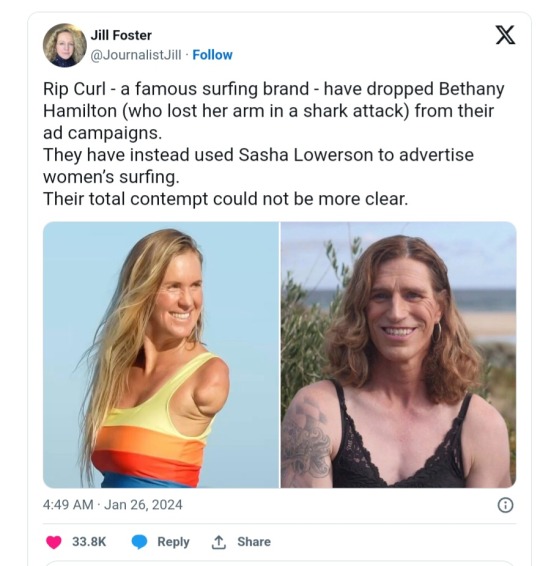
Many women called for consumers to boycott the brand.
“Company @ripcurl hired a MAN to advertise their women’s line, rather than an amazing female athlete. Amazing. They hate women don’t they. Don’t buy anything from these people. #BoycottRipCurl,” one critic said on X.

“Imagine dropping an athlete that survived a shark attack and went onto be one of the best surfers in the world for a mentally ill Man competing in women’s surfing? Seriously Ripcurl? #BoycottRipCurl,” wrote another woman.
#BoycottRipCurl has been trending on X for the last two days as women continue to express their outrage.
Lowerson has made his Instagram account private following the backlash. However, Reduxx was able to obtain photos from the page showing Lowerson modeled sexually suggestive outfits with captions that related to his surfing career.
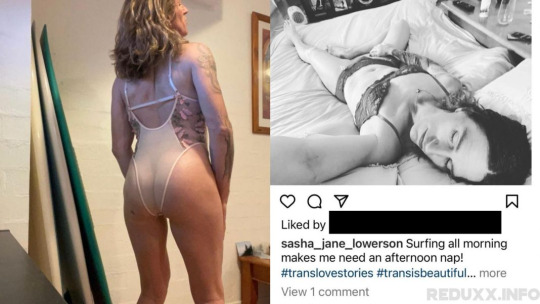
Since news of Lowerson’s partnership with Rip Curl first broke, female athletes have spoken out against the brand and in support of Hamilton.
Swimming Champion and activist for women’s sports Riley Gaines called out Rip Curl on X, encouraging her followers to boycott them.
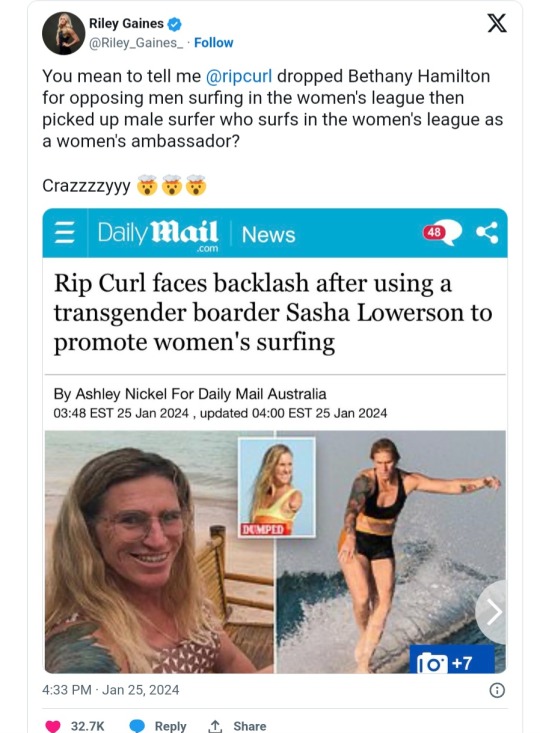
In a follow-up post, Gaines stated: “Encouraging to see so many people reply that they’re throwing out their Rip Curl apparel and pledging not to buy from them again. I didn’t know people still wore Ripcurl anyways. RIP Rip Curl.”
Gaines has been outspoken against the inclusion of male athletes in female sports after she was forced to compete against Will “Lia” Thomas in the 200 freestyle final at the NCAA Women’s Championships in 2022. Gaines and Hamilton are expected to join forces to host a story hour for children on 2nd February in Springfield, Missouri to celebrate the launch of their new books, “Happy No Snakes Day” by Gaines and “Surfing Past Fear” by Hamilton. Trans activists are expected to protest the family event.
Skateboarder Taylor Silverman also chimed in to condem Rip Curl. Silverman has also been outspoken against males competing in female sports since voicing her own experience being displaced by males participating in women’s skateboarding.
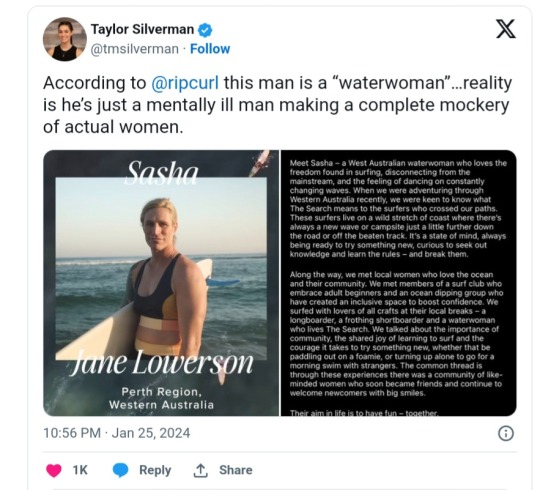
Anyone else thinking that when this guy won his last event in a men's competition he saw a lot of younger competition and knew that his days surfing professionally was coming to an end unless he did something drastic?
"The 25- to 34-year-old age bracket is the largest, with 24 percent of the total surf population.
Surfing is dominated by youth – as 71 percent of the total surfing participants are in the 6- to 34-year-old age range.
In fact, 87 percent of all surfers are younger than 44 years old. "
A quick Google search confirms that "sasha" is 44.
#australia#BoycottRipCurl#Bethany Hamilton spoke the truth#World Surf League#International Surfing Association#Rip Curl Women now with Men#Sasha Jane Lowerson is another male who transitioned after a successful career in men's sports#Rip Curl locked their Instagram
71 notes
·
View notes
Text
Ellie Carpenter calls out online abuse but shrugs off her own
“The bigger you get, the more criticism you get.”
Ellie Carpenter is authorised to speak on this subject. Mainly because her football career has got real big, real quick – she is 23, has been playing for global powerhouse Lyon for three years, and been the Matildas’ undisputed starting right-back for even longer.
But also because the peak of that career – playing in a World Cup semi-final in her home country – brought with it criticism which would more accurately be described as abhorrent social media trolling.
It happened in August, when Carpenter failed to clear a long ball that resulted in England’s second goal of the Lionesses’ 3-1 win. It was a mistake that left her visibly “heartbroken” after the match, but it did not warrant what former Socceroos captain Craig Foster described at the time as “vile, misogynistic garbage”.
The abuse forced her to limit replies on social media, which were also flooded with supportive messages from fans, friends and teammates, including captain Sam Kerr, who told media she was “mentally one of the toughest kids I’ve ever met in my life”.
Sometimes it is hard for an outsider to know how much this “outside noise” – as many sports people, including Carpenter, call it – affects the individual at its centre. For some, it can devastate mental health and on-field performance. If that is the case with Carpenter, you wouldn’t know it.
Two months after the World Cup, she has been back in the thick of it with Lyon, who are once more top of France’s Division 1 Feminine table, and is now back in Australia answering questions about online abuse she would probably rather not be answering.
“To be honest, I don’t really read or look into that,” she says in Perth, where the Matildas are preparing to play three Olympic qualifiers.
“It doesn’t really affect me at all, because I do a job for my team and myself. I don’t really listen to outside noise. I had a great support system around me during that time, and just during the whole World Cup really.
“It [online abuse] is everywhere these days, and that just shows that the bigger you are, or the bigger you get, the more criticism you get. That comes with being a professional athlete as well.
“You see it everywhere in different leagues, different sport codes. So obviously it’s a problem, and I know a lot of people are trying to make apps and platforms to try and stop abuse and things like that, so that’s good that people are aware of it and are trying to change it.”
Carpenter is an old, independent soul for her 23 years. When she contested the World Cup, she did so after recovering from an ACL rupture, in another country, and opting for little personal support except from her partner and teammate, Dutch international Daniëlle van de Donk.
“You have to grow up very quickly,” she says. “I moved out of home when I was 15 and was living by myself, so you grow up automatically.
“I didn’t really get much downtime [after the World Cup]. You just kind of go straight into a new season, so you don’t really have time to reflect or stop for a second.
“But it’s been incredible to see the aftermath of the World Cup and what we’ve done in football and Australia, and for women as well. I can definitely be proud of that.”
Carpenter is allowing herself to enjoy her time in Perth. She was released early by her club and arrived over the weekend, so enjoyed a couple of extra days to recover from jet lag.
75 notes
·
View notes
Text


THE FIRST SINGLE … ˗ˏˋ ꒰ ♡ ꒱ ˎˊ˗
“GIRLS DON’T CRY” is the debut single by CHOUKA AIKAWA. Released on April 5th, 2024, the song went on to top charts in various countries. Hailed as one of the best debuts of 2024, critics and fans alike fell in love with the song’s “girlish” and carefree production, and praised how Chouka stayed so true to her hyperfeminine, “princesscore” image. The song’s success as caused critics to name her as a pop girl on the rise.

TRACKLIST … ˗ˏˋ ꒰ ♡ ꒱ ˎˊ˗
GIRLS DON’T CRY ! LEAD SINGLE
CAKE ! B-SIDE
GIRLS DON’T CRY (SPED UP)

PHOTOCARDS … ˗ˏˋ ꒰ ♡ ꒱ ˎˊ˗

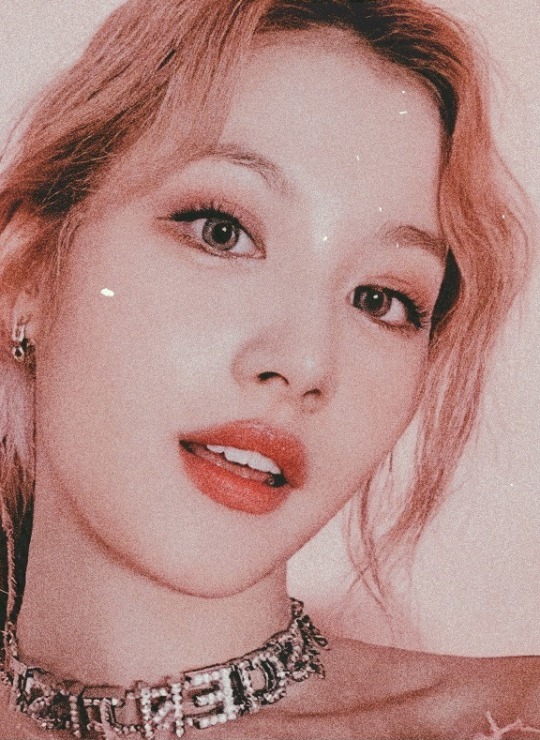


COMMERCIAL PERFORMANCE … ˗ˏˋ ꒰ ♡ ꒱ ˎˊ˗
Highly praised for its sound and how it fit Chouka’s style, “Girls Don’t Cry” was a resounding success. The music video’s teaser, which was released with no prior notice onto a completely new YouTube channel (“c.a.”) with no previous content (it was later turned into a channel for all of Chouka’s music related endeavors), garnered over 3.2 million views within its first twenty-four hours after Chouka posted it to her Twitter and Instagram accounts. The single’s title was revealed on both platforms an hour later, coinciding with the launch of her official website, which displayed the title alongside a countdown timer.
The song received over 400,000 pre-saves, and the title was trending on Twitter with over a million Tweets. Shortly before “Girls Don’t Cry” dropped, Chouka’s website was updated with the single’s cover, and she posted behind the scenes photos of her on its set, which received over two million likes within the first day.
Upon the song’s release, it was a smash hit. The music video garnered 32 million views within its first 24 hours, finding itself at #1 on YouTube’s trending page, and topping both the Spotify and Apple Music charts. It went on to become the second most streamed song on Spotify in regards to first day streams. “Girls Don’t Cry” topped charts in several countries, including Japan, South Korea, Australia, the United Kingdom, Italy, France, the Netherlands, New Zealand, and the Philippines (it also managed to remain atop the Oricon chart for seven weeks).
Surprisingly enough, “Girls Don’t Cry” would debut at #2 on the Billboard Hot 100 with sales of over 200,00 units, despite industry insiders predicting a Top 20 debut; probably due to the song’s immense popularity online. Unfortunately, it would never reach #1, falling to #7 after five weeks and staying there for two until falling off, but Rosettes were still happy to see that Chouka’s debut managed to get that high. In total, the single would sell over 850,000 units within its first week, cracking a million by the end of April.
Additionally, the song was also praised for its lyricism and feminist commentary on how women who are seen as “strong” or “smart” are not allowed to cry or display negative emotions and are expected to act as role models, while women who appear as if they have everything are told to “just deal with it” and that they have “nothing to be upset about.” Many Rosettes (and critics) were also surprised to find out that Chouka had written most of the lyrics, as she never expressed interest in songwriting before.
“Cake” was released as a single a month later, on May 3rd, 2024. Although the music video received over 11 million views within its first twenty-four hours, Rosettes were … a bit divided. It seemed like none of them could figure out whether they liked the song or not, with certain Tweets saying …
˗ˏˋ ꒰ ♡ ꒱ ˎˊ˗ “ y’all are just HATERS ! like y’all have truly forgotten what real pop music sounds like bc cake is a hit idc ! ”
˗ˏˋ ꒰ ♡ ꒱ ˎˊ˗ “ chouka girl with all due respect i think letting a major label get a hold of you was a mistake ”
˗ˏˋ ꒰ ♡ ꒱ ˎˊ˗ “ no bc this is girly girl music ! it’s cute it’s fun it’s bouncy and it’s so HER ! chouka bby get behind me PUT DOWN THE HATERADE NOWWWW !! ”
˗ˏˋ ꒰ ♡ ꒱ ˎˊ˗ “ #notmychouka girl why does this sound so EMPTY ??? republic needs to pay for their crimes bc ….. ”
Despite the confusion, “Cake” also went on to top charts. It also debuted atop the Apple Music chart, and came in second beneath “Girls Don’t Cry” on Spotify. It managed to debut at #6 on the Billboard Hot 100, although Rosettes were gunning for a higher placement (it was definitely because they couldn’t stop beefing with each other). The song remained on the chart for two weeks (managing to jump to #5 during its second), before completely falling off the Top Ten.
Luckily, more retrospective reviews shows that Rosettes have warmed up to “Cake,” saying that it fit the aesthetic of the lead single. Everyone loved the “sugar sweet” concept that Chouka had going on, and expressed pleasant surprise that her try at a music career was going so well.

STYLING … ˗ˏˋ ꒰ ♡ ꒱ ˎˊ˗

ERA HIGHLIGHTS … ˗ˏˋ ꒰ ♡ ꒱ ˎˊ˗
Definitely a fun era! Republic was truly pushing this single and girl, it showed. There were billboards playing her music video (Rosettes in New York even crowded around one when it first launched), ads plastered all across YouTube, “Girls Don’t Cry” was all over the radio, and it was the most popular song on TikTok for a good month.
The promotions were insane! Chouka was all over television this era. She was on the Kelly Clarkson Show (which was too cute! Like Kelly literally complimented her accent), she was on Jimmy Fallon, she was on GMA … like you truly could not escape her! She also had a photoshoot with Harper’s Bazaar and people ate it up! It was very Marie Antoinette themed with huge dresses, pastries, and of course, it was shot at a chateau in France!
And of course she had to promote in Japan! Chouka performed both “Girls Don’t Cry” and “Cake” on Music Station, and no one expected either song to have choreography. But the choreo was so cute, and especially for “Girls Don’t Cry!” Like you could truly tell that Chouka was having a blast, and everyone was so surprised at her stage presence because she’s literally a YouTuber. She also held a press conference in Tokyo, and she even got to visit a pop-up event held by Rosettes at a café in her hometown, Kyoto! It was the cutest thing to see her interacting with her fans, and she thanked them at least five times.
Chouka managed to squeeze in Korean promotions, as well! She performed both of her singles on M Countdown, Inkigayo, and The Show, and she was even on Weekly Idol! She held a small fansign for 200 fans who participated in the pre-order and received a “mystery ticket” with their album, and it was so cute! Chouka was cracking jokes with them and receiving SO many gifts (most of which were either pink or ridiculously expensive; she got a lot of bouquets, too!). Her Korean promos even saw the birth of her first fansite, Strawberry Sweet! She also appeared on the cover of Vogue Korea, and after that, Korean promotions ended unfortunately.
Side note, every performance of “Girls Don’t Cry” started with a costume change! It was usually Chouka tearing off a huge ball gown like skirt to reveal her shorter costume underneath, and her performance on M Countdown was literally her playing a princess getting ready for a ball. There was also a lot of ribbons, platform heels, and satin gloves used styling wise, and Chouka’s makeup was always so soft and pink!
Although she didn’t have enough songs to perform a full set, Chouka attended Coachella anyways and met a bunch of Rosettes! Jason (her fiancé) also tagged along, so fans got to meet him, too! Fashion girls were all over her festival looks too … being raised in Milan truly did wonders for her fashion sense.
Girl, the way the “#GirlsDontCryChallenge” blew up on TikTok is insane. The song had over a million videos underneath it by the start of June, and Chouka was doing it with celebs like Kelly, Tate McRae, Olivia Rodrigo, the members of Aespa, the members of Itzy, Rosé of BLACKPINK, Nayeon and Momo from TWICE, Yuju, the members of Viviz, and a few members of Stray Kids and NCT; among others! Chouka also did the challenge with Leeseo, Rei, and Wonyoung of IVE, and the way Dives and Rosettes were across every social media app absolutely freaking out that Chouka and Wonyoung were the same room was truly crazy.
Towards the end of promotions, a full length documentary covering the making of “Girls Don’t Cry,” the music videos, and the subsequent performances premiered on YouTube. It was a mix of professional camera shots and footage personally shot by Chouka herself, which was refreshing since Rosettes got to see a sillier side to her personality. The documentary garnered over 3 million views within the first twenty-four hours, and would end up at #5 on YouTube’s trending page.
At the end of promos, Chouka posted a long, heartfelt letter to her Instagram thanking fans for their support and expressing how surprised she was at the single’s success. She wrote, “I know that you guys have been waiting three years for me to try my hand at music, and words cannot express how happy I am that it was worth the wait. Over these last few months, you all have shown me so much love, and just thinking about it is moving me to tears as I write this! I promise that I’ll repay your support tenfold. You guys truly mean the world to me, and I wouldn’t be half the person I am today if it weren’t for you. You are truly my other half, even if I unfortunately don’t know you personally (don’t tell Jason I said that). I hope and pray that one day, I’ll be able to meet every single one of you from around the whole world in person, and tell you just how much you mean to me. Until next time, my loves. Ti amo sempre e per sempre. Ciao ciao. ♡”
Additionally, there was also a remix planned with PinkPantheress, but unfortunately, plans ended up falling through because Chouka simply … didn’t want to do it. However, Rosettes ended up finding out about the planned collab, and demand for it was huge. So the remix could happen in the future! Who knows.
All in all, this era was great. It truly showed how much untapped star power Chouka had, and the numbers proved it. It reinforced her “It girl” status, showing that no matter what industry she tried her hand at, she would still dominate. ˗ˏˋ ꒰ ♡ ꒱ ˎˊ˗
#precursor to an upcoming blog …….#cece writes :)#oc#kpop idol oc#fictional kpop oc#kpop soloist#kpop solo artist#fictional idol oc#fictional idol#fictional idol community#fake idol#fake idol oc#fake kpop idol#fake soloist#fake kpop soloist#fictional soloist#jpop oc#jpop idol oc#fictional jpop oc#jpop soloist#jpop solo artist#fictional jpop idol#fake jpop oc#fake jpop idol#fake jpop soloist
9 notes
·
View notes
Text

Womens tops online in Australia
Shop the latest womens tops online Australia at Insurge Clothing. Find trendy, eco-friendly styles, including casual tees, elegant blouses, and bold statement tops. Perfect for any occasion, our collection blends comfort and style, made from sustainable fabrics for modern fashion.
#ladies tops online australia#women tops online#ladies tops online#womens tops online australia#buy tops online australia
0 notes
Text
When it comes to Australia’s national regulators, women rule.
Women now dominate the leadership of federal regulatory and oversight agencies that enforce rules for business and the economy, with 33 women holding chief executive or chair roles. This signals a profound shift for the nation’s top watchdogs, once almost solely the domain of male enforcers.
Rapid digitisation and rising globalisation are making traditional black letter enforcement approaches less effective, leading to women with so-called solid soft skills, such as influence, collaboration and communication, winning top-tier regulatory roles.
Women are now at the front line of the battles against scams, identity and data theft, cyber ransomware attacks, electronic espionage, digital surveillance, misinformation, social media abuse and dark web criminality.
“It’s very different to the skills base you needed a decade or two ago where it was just about telling people what to do, and they would toe the line,” says Ann Sherry, a former head of the Office of Status of Women in the Hawke and Keating governments.
“Those jobs were filled by a particular sort of person cast as a regulator. So, in a way, it was almost an enforcement role, whereas the jobs have changed.”
The leadership of the federal public service reached gender equilibrium last year.
Sherry, who is now QUT chancellor and chairs Queensland Airports, digital marketing firm Enero and UNICEF Australia, says that the public sector has been better at promoting women through the ranks but that many women have also built relevant skills in the private sector.
“Many women have had to broaden their careers and build a broad set of skills to be successful. There is now a body of capability to draw up. The talent pool has changed, and the jobs require broader skills. It is a confluence of events,” she says.
The surge in women leading federal regulators compares with 19 women (10 per cent) chairing ASX200 companies and 26 women (9 per cent) who are CEOs across the ASX300, as at the end of 2023.
Competition chief Gina Cass-Gottlieb and Reserve Bank of Australia governor Michele Bullock (who also chairs the Payments System Board) are the first women to lead their institutions. Others, such as media watchdog Nerida O’Loughlin and energy regulator Clare Savage, have won second appointments.
A push to bring in new blood from outside the Australian public service helped veteran NSW regulator Elizabeth Tydd win an appointment as head of the Australian Information Commission. Carly Kind was tapped from a London think tank to be the new privacy commissioner.
They join a swag of women now overseeing vast swaths of the economy, including infrastructure (Gabrielle Trainor), aviation (Pip Spence), food (Sandra Cuthbert), petroleum (Sue McCarrey) and fisheries (Helen Kroger).
Others such as Rachel Noble (espionage), Julie Inman Grant (e-safety), Jayde Richmond (anti-scams centre) and Michelle McGuinness (cyber co-ordinator) are focused on rapidly emerging harms, including national security threats, identity and data theft, consumer abuse, online scams and fraud.
Workplace and safety regulators are now dominated by women too, including Anna Booth (Fair Work Ombudsman), Joanne Farrell (Safe Work Australia), Jeanine Drummond (maritime safety), Natalie Pelham (rail safety) and Janet Anderson (aged care).
The dominant role female regulators play has been part of a profound shift in the number of women in leadership roles in the Australian government. This has risen from a quarter of executive roles being held by women 20 years ago to over 50 per cent last year.
Battle ready
Australian Competition and Consumer Commission chair Gina Cass-Gottlieb, who rose through the ranks as a competition lawyer at law firm Gilbert and Tobin, says her generation of leaders had battled their way through male-dominated workplaces.
“In those workplaces, to get ahead, we needed to target the areas we thought were most important to make an intervention and where we could most effectively make an impact.
“We actually had to build skills to succeed, which are beneficial skills in these roles.”
Ms Cass-Gottlieb says women have also had to differentiate themselves. “You needed to point to other ways of working, including creative and different solutions that drew from experience in various areas rather than a pure step-by-step standard career path.”
Australian Information Commissioner Tydd points to Columbia University research that measured creativity by analysing songs, finding that women created more songs than men.
“Digital government requires a creative use of proactive tools to identify and mitigate future harm. It’s the unforeseen or latent harms that are the most refractory and so we’ve got to look at diagnosis and predictive tools, and that’s where you start to get a bit creative.”
Tydd says she was attracted to regulatory work because of the value of promoting open government, transparency and accountability.
“I think that seeking service and purpose orientation are factors that drive people into this work and I do think seeking service is a very comfortable and well-established motivation within women.”
Demand for new approaches
According to ANU Crawford School of Public Policy director Professor Janine O’Flynn, the data on the importance of public motivation for women is mixed. However, she suggests that women’s more attuned risk and relationship skills help them to be more effective regulators.
“We certainly know that the most effective models of regulation are around how you can think about risk and how you build relationships with the parties that have been regulated.
“I don’t mean that in a sort of dodgy way. The higher the trust relationships you can get between regulators and those who are regulated, the more likely you are to get the outcomes that you’re looking for.”
Read the full article in the link above!
5 notes
·
View notes
Text
Hot take I'm seeing quite a few posts confused over why Deadloch isn't trending or much more popular on tumblr because "tumblr is so gay and so feminist". And I am sorry to say this but tumblr isn't the "lesbian website" or the "feminist website". Tumblr loves men just as much as the rest of society does, its user base just loves them in a very online way which makes it look a bit different at times. It has always been this way, starting with shipping every two white dudes in close proximity to each other, over worshipping old male Hollywood actors to downright MRA and anti-feminist talking points in the recent past in "progressive leftist" spaces on here. All done in very uwu political correct tumblr speak of course.
And it's really that simple. Media with two (often times white) guys standing close to each other will always be more popular on here than anything women- or lesbian centric, no matter how many theoretical tumblr approval boxes said media ticks. There is a reason why lesbian shows get canceled left and right. Even if lesbian shows are trending for one or two days there is just no genuine interest from a majority of people (on tumblr and anywhere else). Men overall are rarely interested if it isn't made with the male gaze in mind or focusses on men, straight women aren't interested, even many bi women (don't come at me I am bi) aren't interested because they don't see other women (and often times themselves) as complete and potentially interesting people/characters (how often I've seen women on here saying something along the lines of "my favourite characters are all men but it's just because these characters are so good! Pure coincidence. I would definitely love a female character but I just have never found one I am that obsessed with. Not my fault, they are all written in a bad/boring way").
Doesn't matter how often the word "queer" is thrown around here, all of this has always been the same and it won't change. Which is.. fine? I have never expected it to be something else. A website that isn't specifically designed for lesbians but only attracts lesbians would be magical. But a website thats designed for nerdy people and especially women of that kind will attract.. nerdy people/women. Consisting of the same groups of people that exist in real life, including lots of women attracted to men. I have my little bubble here in which I mainly see lesbian content but the things on my dashboard rarely reflect what's trending or the content of popular posts.
I am not bitter about this because it has never been different (here or anywhere else) but I am surprised that people are still thinking that this website would worship a lesbian-lead and female-centric show when it would be entirely out of character for tumblr as a whole to do so. I mean maybe this is all about the show being australian. Maybe people don't like Australia. I also get that crime shows aren't THAT popular either but I guarantee you, if Dulcie and Eddie were dudes this show would be trending so hard.
Deadloch is a fantastic show. It looks amazing, has fantastic humor, the drama is great, the plot is great, there is a good message behind everything and the show also sprinkles in some of tumblrs top ten greatest political correct catch phrases. The main two characters are played by lesbians, another actress from the main cast is bisexual. One of the main characters is a lesbian and there are several other lesbian characters in the show. The other main character is a woman of color (who SHOULD be same sex attracted but sadly seemingly is not which makes me cry). Almost all important characters are women. Amazingly written by the way. There are plenty of women of color, indigenous women especially, playing important roles. All female characters are complex and nuanced people and their suffering isn't used for shock value or to push forward the plot. The two main female characters are both over 40 years old! What the show doesn't have is the same two decent looking men standing in close proximity to each other. And there really isn't any arguing against my little rant here because the only thing I accept as proving me wrong is a lot of people watching Deadloch or overall more women centric and lesbian centric stuff :) Thank you :)
13 notes
·
View notes
Note
I get a little discount one but the ordering process is a pain in the arse bc it's offline through HR rather than a code to use online.
Product wise, I prefer my leisurewear shoes to be nike just cause my feet shape, but I love running shoes from Adidas. I have both. Sometimes colourways matter.
Bottoms definitely adidas, since I'm plus size but even though adidas do bigger range for tops nikes fit better and i wear more nike tshirts + material is a little thicker so you cant see through my white nike top as much as my white adidas tshirts. But as you get the more professional range like the strike range (which is what england, Australia etc have but customised colours) the fits gets smaller. So an L feels like and M. I. General adidas are better at consistent sizing across their ranges year by year but adidas sometimes are a lil short for my long ass torso. But nike you can have a match shirt from 2022 and 2023, both size XL and one be longer than the other. We've actually measured them. 🤣 I wear mens bc im tall and masc but getting womens fits into stock is a nightmare. Especially new stuff, its never ready at the same capacity for ordering into stock as mens and juniors. Anyway yeah. Love nike and adidas. I'd never commit to working with one or the other knowing I wouldn't be allowed to wear the other but genuinely love and hate both for different reasons.
Shorts are another adidas win. Hoodies....neither. had problems with both with inconsistent sizing and wearing quickly.
Thank you so much. This is extremely insightful. Think this will be helpful to a few people!
2 notes
·
View notes
Audio

Dior Homme Intense fragrance for women is a sensual and alluring perfume that is sure to turn heads. With its rich and captivating scent, this fragrance is perfect for women who want to exude confidence and sophistication. It features notes of iris, vanilla, and amber, which come together to create a warm and inviting aroma that is both sweet and spicy. Available at Scent God, an online perfume store in Australia, this fragrance is a must-have for any woman who wants to feel irresistible and powerful. So, if you're looking for a new signature scent that is sure to leave a lasting impression, look no further than Dior Homme Intense fragrance for women.
#top fragrances for women#dior homme intense australia#online perfume store#buy perfume online#buy women perfume#buy fragrance online#buy luxurious fragrance
0 notes